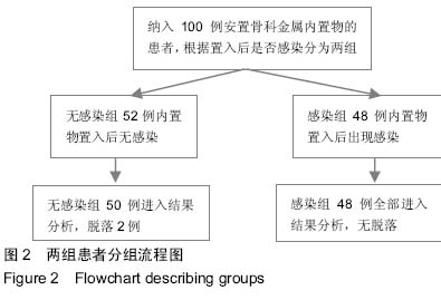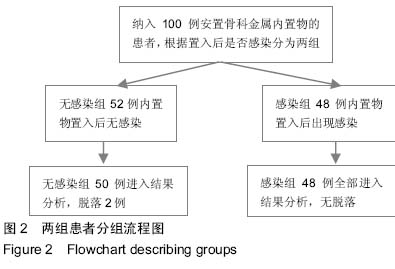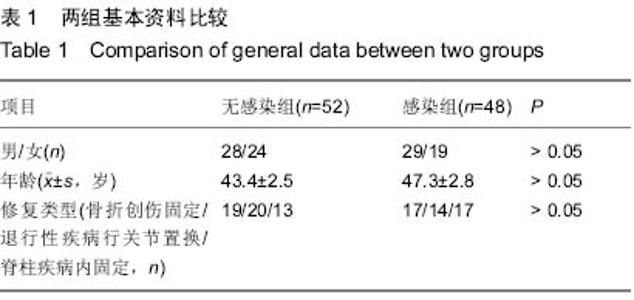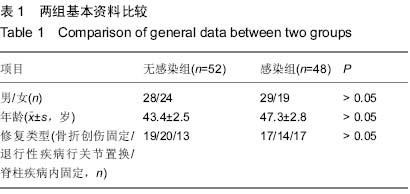| [1] 崔利宾,陈学明.腰椎手术后血清C-反应蛋白测定的临床意义[J].现代中西医结合杂志,2010,19(19):2391-2392.
[2] 熊铁,曹琼,薛灏,等.B27分子对脊柱炎患者C-反应蛋白和红细胞沉降率的影响[J].广东医学,2012,33(24):3777-3778.
[3] 宋炎成,张慧慧,卢华定,等.CRP、ESR在关节置换手术前后变化及其临床意义[J].中国矫形外科杂志,2008,16(11):823-824.
[4] Bauer TW,Brooks PI,Sakai H,et al.A diagnostie algorithm for detecting an infected hip arthroplasty. Orthopedics. 2013; 11(26):929-930.
[5] Ip D,Yam SK,Chen CK. Implications of the changing pattern of bacterial infections folowing total joint replacements. J Orthop Surg. 2012;13(2):125-126.
[6] 谢强,雷光华.血液炎性标志物用于关节假体感染诊断的研究与应用[J].中国组织工程研究,2012,16(44):909-910.
[7] Ong KL,Kurtz SM,Lau E,et al.Prosthetic joint infection risk after total hip arthroplasy in the medicare population. J Arthroplasty. 2010;24(6):105-109.
[8] Wong TC,Chan WF,Tsang WL,et al.Mycobacterium fracingogenes infection after total hip arthroplasty. J Arthroplasty. 2010;20(5):684-685.
[9] Bongartz T,Halligan CS,Osmon DR,et al.incidence and risk factors of prosthetic joint infection after hip or knee replacement in patients with rheumatoid arthritis. Arthritis Rheum. 2010;59(12):1713-1720.
[10] 张德刚,于腾波.人工关节置换后假体感染的诊断和治疗研究进展[J].青岛大学医学院学报,2010,46(1):90-94.
[11] Sawhney R, Berry V.Bacterial biofilm formation, pathogenicity diagnostics and control:an overview. Indian J Med Sci. 2010; 63(7):313-314.
[12] 孙国荣,肖四旺.桃红四物汤对膝关节置换后血清IL-2/IL-6、TNF-α表达水平的影响[J].湖南中医药大学学报,2008,28(3): 32-34.
[13] Grimier RJ,Abudu A.Infection after total hip arthroplasty. J Bone Jonit Surg Br. 2010;87(4):588-592.
[14] Padgett DE,Sliverman A,Sachjowicz F, et al.Effecacy of intraperative cultures obtained during revision total hiparthroplasty.J Arthroplasty. 2010;10(4):420-426.
[15] 林辉,陈永涛,张进,等.抗环瓜氨酸抗体联合类风湿因子检测在类风湿关节炎诊断中的应用[J].现代医药卫生,2013,21(1): 3205- 3206.
[16] 莫巧旋,张简霞,张劲丰,等.探讨抗环瓜氨酸抗体和类风湿因子对类风湿关节炎的诊断价值[J].检验医学与临床,2013,16(1): 2104-2105.
[17] 梁少群,吴兴柳,赵明聪,等.C-反应蛋白在感染性疾病鉴别诊断中的临床应用[J].中国民康医学,2013,25(14):909-910.
[18] Afshari A,Pagani L,Harbarth S. Year in review 2011:Critical Care-infection. Crit Care. 2012;16(6):242-243.
[19] 单小鸥,何时军,钱彩.C-反应蛋白在预测细菌感染中的作用[J].中华急诊医学杂志,2007,12(3):295-296.
[20] Douraiswami B,Dilip PK,Harish BN. C-reactive protein and interlukin-6 levels in the early detection of infection after open fractures. J Orthop Surg. 2012;20(3):381-385.
[21] 杨琼,俞文萍,张艳.血清前白蛋白和C-反应蛋白检测在小儿感染性疾病诊断中的应用[J].中华医院感染学杂志,2012,22(10): 381-385.
[22] Devran O,Karakurt Z,Adgtizel N. C-reacted with severe sepsis in intensive care unit. Multidiscip Respir Med. 2012; 7(1):47-49.
[23] 崔庆,徐延景,张建勇.普外科感染患者血清中降钙素原及C-反应蛋白检测的临床意义[J].中华医院感染学杂志,2011,21(15): 3181-3182.
[24] 李春根,曲戈,叶超,等.组织工程软骨与油皮苷联合修复兔膝关节软骨缺损的组织学证实[J].中国组织工程研究,2014,18(20):909 -910.
[25] 刑梅芳.肺炎支原体感染患儿血常规、超敏C蛋白变化分析[J].中国医学创新,2014,11(31):456-457.
[26] 王小辉.全膝关节置换术患者围手术期血清炎性指标与红细胞沉降率变化研究[J].中国医药指南,2013,11(23):405-406.
[27] 吴林飞,徐旭仲,董小秋,等.超前镇痛对全膝关节置换术后疼痛及患者血浆P物质和血清IL-6的影响[J].苏州大学学报:医学版, 2010, 30(3):608-610.
[28] 王云芳.人工关节置换术后C-反应蛋白、血沉的变化分析[J].中国卫生产业,2012,9(23):109-110.
[29] 聂国利. 骨科手术后C-反应蛋白表达意义与术后感染相关性分析[J].中国现代药物应用,2013,7(21):72-73.
[30] 马永东,谢晋,胡英江,等.C-反应蛋白和红细胞沉降率对判断骨科术后感染的价值[J].检验医学与临床,2010,5(20):1279-1280. |





